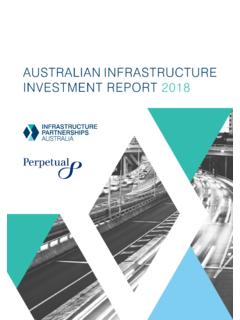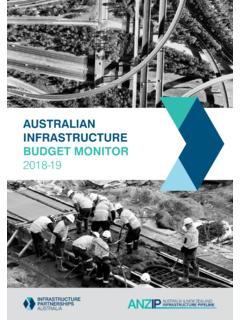Transcription of AUTOMATED VEHICLES - infrastructure.org.au
1 AUTOMATED VEHICLESDO WE KNOW WHICH ROAD TO TAKE?Infrastructure Partnerships Australia is the nation s peak infrastructure body formed in 2005 as a genuine and enduring policy partnership between Australia s governments and industry. IPA s formation recognises that through innovation and reform, Australia can extract more from the infrastructure it s got, and invest more in the infrastructure we need. Through our research and deep engagement with policymakers and industry, IPA seeks to capture best practice and advance complex reform options to drive up national economic prosperity and competitiveness. Infrastructure is about more than balance sheets and building sites. Infrastructure is the key to how Australia does business, how we meet the needs of a prosperous economy and growing population and how we sustain a cohesive and inclusive society.
2 Infrastructure Partnerships Australia draws together the public and private sectors in a genuine partnership to debate the policy reforms and priority projects that will build Australia for the challenges value by solving the world s critical resource, energy and infrastructure challenges. Advisian understands specific commercial, technical and collaboration challenges proudly accessing decades of project and business experience to provide informed advice and ensure strategic, practical and commercially orientated solutions. As the independent consulting business line of the WorleyParsons Group, Advisian provides a true end-to-end offering for clients, with approximately 2,700 consultants across 19 countries integrating strategy, management and technical consulting the advice and partnering with our clients to implement that advice, we are a practical, innovative, results-driven organisation with a singular focus on the success of our clients.
3 We are open, honest and direct, and we deliver what we promise. We advise, then further information about our capabilities and the projects we have worked on, please visit our website at Research Centre for Integrated Transport Innovation (rCITI) is based in the School of Civil and Environmental Engineering at the University of New South Wales (UNSW), Sydney and represents a strategic effort that unites and extends the wide range of transport research across the UNSW aims to reshape the field of Multi-modal Transport Engineering and Planning by introducing new innovative techniques and technologies, which enhance society, by integrating across methodological disciplines and contextual considerations.
4 The Centre bases all research activities around five core research pillars: Transport Planning Find better methods to plan integrated transport systems. ITS Communications Improve transport systems through communication technology. Infrastructure Develop new materials, techniques, and tools to improve infrastructure. Energy/Fuel Find ways to utilise energy/fuel more efficiently in the transport system. Computational Sustainability Find better ways to assess transport systems to improve , Level 3, 95 Pitt Street Sydney NSW 2000 PO Box R 1771 Royal Exchange, NSW 1225 17, 141 Walker St North Sydney NSW 2060 University of New South Wales School of Civil and Environmental Engineering Civil Engineering Building (H20) Level 1, Room CE110, Kensington Campus Lyon Chief Executive Officer P +61 2 9152 6000 E Hudson Director, Economics and Policy P +61 2 9152 6018 E Twycross Policy Adviser P +61 2 9152 6012 E Maklary Principal P +61 3 9810 5725 E S.
5 Travis Waller Director, RCITI P +61 2 9385 5721 E The Authors would like to acknowledge the work of Dane Logan, Andrew Lau and Alex Li-Kim-Mui of Advisian and Dr. Hanna Grzybowska and Dr. Kasun P Wijayaratna of UNSW RCITI in producing this Finn Global CEO P +61 3 9810 5700 E Porter Managing Director APAC P +61 2 9495 0500 E 2017 Infrastructure Partnerships AustraliaDisclaimerInfrastructure Partnerships Australia provide no warranties and make no representations in relation to the information provided in this paper. It is not intended for and should not be relied upon by any third party and no responsibility is VEHICLES : DO WE KNOW WHICH ROAD TO TAKE? 1 ContentsExecutive Summary 2 Recommendations 41 Introduction 6 POLICY CHALLENGES FOR AN UNCERTAIN FUTURE 7 YOU TAKE THE HIGH ROAD AND I LL TAKE THE MIDDLE ROAD 82 Understanding the AUTOMATED vehicle ecosystem 9 DEFINING AUTOMATION LEVELS 10 DEFINING AVS AUTONOMOUS ONLY OR CONNECTED AND AUTONOMOUS VEHICLES 10 BENEFITS 13 Safety 13 More efficient road use 13 Enhanced mobility and changing travel patterns 14 Enhanced data and information 14 Direct transport costs 14 CHALLENGES 14 Winning trust.
6 Operational safety and data confidentiality 14 Infrastructure 15 Legal and ethical considerations 16 Privacy considerations 16 Short-term economic considerations 163 Current state of play 17 INTERNATIONAL EXPERIENCE 17 Asia 17 Europe 17 United States 18 AUSTRALIA 19 Implementing regulatory change 19 Legal and regulatory barriers 204 Infrastructure considerations 24 IF ROADS COULD 25 OTHER POTENTIAL CHANGES 26 Parking areas 26 Drop-off zones 26 Transport interchange 26 An inflection point 265 Conclusion 29 Abbreviations 30 Appendix 1 Levels of automation 31 References 322 AUTOMATED VEHICLES : DO WE KNOW WHICH ROAD TO TAKE?
7 Executive SummaryAutomated and Driverless VEHICLES (AV/DVs) offer the prospect of positive and fundamental changes to the way Australia s cities work and how people utilise transport. At the highest level, AVs offer massive increases in road safety and capacity and could see car ownership become the exception, with many choosing the lower costs and increased convenience of Mobility-as-a-Service (MaaS).But this shift will not of itself be autonomous fully AUTOMATED VEHICLES do not yet exist for general sale, they are illegal under current Australian laws, and the community has equal levels of excitement and fear about ceding control to AVs at A MIDDLE ROAD Our paper identifies three generalised approaches for policymakers to the prospect of AVs, which we describe as:1.
8 A low road: where regulation and investment severely lags AV adoption;2. A middle road: where regulation is responsive, but follows observed community choices; and3. A high road: where the government sector picks winners in advance of community that AVs are yet to exist on public roads beyond modest trials, we recommend that Australia s governments drive the middle road by ensuring that transport policy and investment decisions neither significantly lead, nor significantly lag, community choices. THE AV FAMILYAVs are something of a catch all term describing VEHICLES that may have quite different levels of autonomy, built around one of two dominant families of AV: Autonomous Only VEHICLES (AOVs) which find their way using on-board sensors; and Connected & Autonomous VEHICLES (CAVs) which communicate with other VEHICLES , road users and road LEGAL?
9 If a fully autonomous or Driverless vehicle (DV) one without a steering wheel became available for sale tomorrow, it could not operate on Australian roads. A range of works have been done by the National Transport Commission and others, examining the changes to law and regulation needed to contemplate AVs, beyond limited trials already underway. Our paper touches on the central issues, which are gathered around definitions of control and the changes AVs require in regard to laws of the work done to identify these impediments, much more work is needed to resolve these areas through concurrent Federal and state legislation. This should be tasked to the National Transport Commission, noting its existing and planned work in this area.
10 Once AVs become street legal , they will likely either require, or substantially benefit from, enabling investments in existing infrastructure. Examples range from modest changes to make signage or lane markings recognisable by the vehicle through to much more expensive investments where Connected & AUTOMATED VEHICLES : DO WE KNOW WHICH ROAD TO TAKE? 3 Autonomous VEHICLES are in constant contact with the infrastructure THE MEASURE OF AVSU ltimately, the decision as to whether and when to undertake modest, or major, enabling investments for AVs must be connected to the number, type and speed of penetration AVs achieve. However ensuring that these decisions neither substantially lead, nor significantly lag community choices will require a system where governments collect and publish details on AVs, including: The number of AVs on the network; Their de-identified location; The level and type of autonomy; and The level of connection they are capable of.


